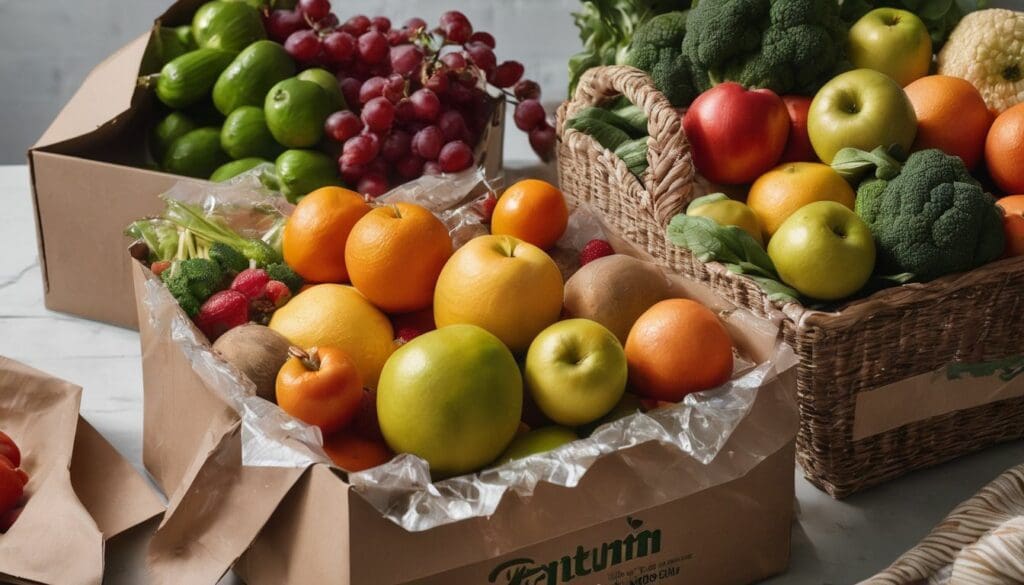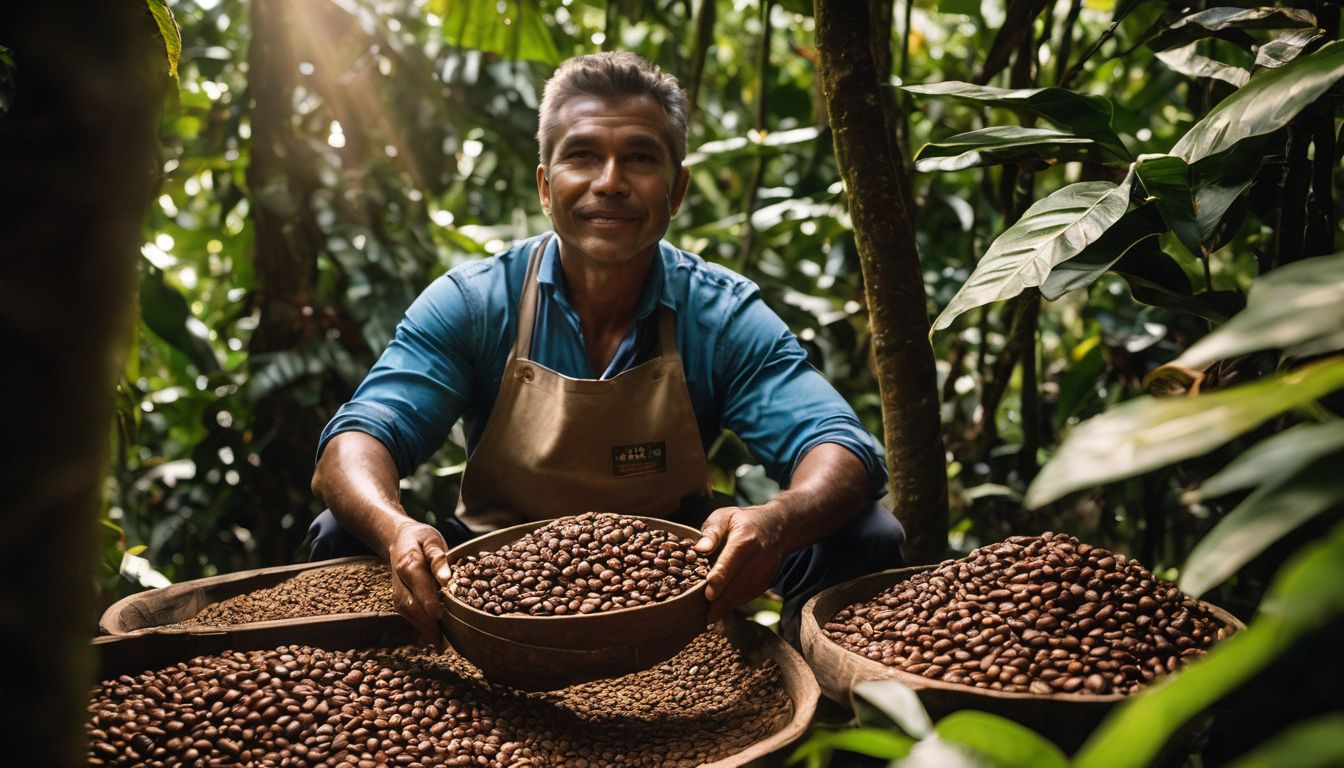As we peruse the aisles, filling our trollies with the weekly shop, it’s hard not to notice how much plastic encases the fruit and snacks on display. It’s enough to give anyone a twinge of eco-angst – that familiar sensation that creeps up as we chuck yet another piece of packaging in the bin, all too aware that a dismal 91% of plastic never sees a recycling plant.
But there’s hope on the horizon. Our journey into sustainability has uncovered some truly brilliant green alternatives; these earth-friendly gems promise all the convenience and quality we’re used to without harming our precious planet.
Join us as we peel back the layers towards a brighter tomorrow!
Key Takeaways
- Sustainable food packaging materials like biodegradable plastics and compostable paper can reduce our carbon footprint and help preserve the environment.
- Innovative technologies in sustainable packaging, such as edible seaweed extract barriers and smart sensors for freshness, are transforming how we store and consume food products.
- Regulations such as EU Regulation (EC) No 1935/2004 ensure safety in food contact materials, while clear labelling helps consumers make informed choices about recyclability and disposal.
- Customised sustainable packaging allows businesses to meet specific consumer needs while adhering to environmental standards, thereby enhancing brand image and loyalty.
- Global advancements like Sweden’s cellulose – based materials demonstrate that worldwide innovations contribute significantly to a more sustainable future in food packaging.
The Importance of Sustainable Food Packaging
Traditional packaging materials pose challenges to the environment, and consumer demand for sustainable choices continues to grow. The impact of sustainable food packaging on brand image and consumer perception cannot be overlooked.
Challenges with traditional packaging materials
We face a significant hurdle when we look at conventional packaging methods. These materials, often plastics made from fossil fuels, not only contribute to pollution during manufacture but also create waste that can last for hundreds of years.
They choke our landfills and oceans alike. The production process itself is energy-intensive and generates substantial carbon emissions, undermining our efforts to combat climate change.
Traditional options like styrofoam and certain plastics can be difficult to recycle due to their complex chemical makeup or food contamination. This reality forces us into acknowledging the need for ecofriendly packaging solutions that align with sustainable practices.
As we consider the impact on ecosystems and wildlife, it becomes clear: businesses must pivot towards green packaging alternatives that ensure safety without sacrificing the environment’s health.
As we navigate these challenges, let’s explore how sustainable alternatives are changing the game for food packaging.
Impact on brand image and consumer perception
Sustainable food packaging can significantly enhance a brand’s image, appealing to environmentally conscious consumers. Using eco-friendly materials and sustainable packaging solutions resonates with individuals seeking ethical and earth-conscious packaging choices.
By demonstrating a commitment to sustainability, businesses can attract and retain customers who prioritise climate-friendly packaging options.
Consumer perception of a brand is directly influenced by its approach to sustainable packaging. Embracing environmentally friendly practices not only contributes to reducing the environmental impact but also strengthens consumer trust and loyalty towards the brand.
Recognising this shift in consumer mindset, companies are increasingly opting for greener packaging alternatives that align with their audience’s values.
Sustainable Alternatives for Food Packaging
When it comes to sustainable food packaging, there are many eco-friendly alternatives available, such as biodegradable and compostable materials or innovative technology like edible packaging.
These options help reduce the environmental impact of conventional packaging and promote a more sustainable future for food products.
Eco-friendly materials
Sustainable food packaging relies on eco-friendly materials, such as biodegradable plastics, compostable paper and cardboard, and renewable plant-based alternatives. These environmentally friendly packaging options are designed to reduce the environmental impact of traditional packaging materials, offering sustainable choices for consumers who are conscious about supporting conservation efforts.
By choosing sustainable packaging materials, we contribute to a cleaner planet by reducing waste and minimising our carbon footprint.
Innovative technology has also paved the way for climate-friendly packaging solutions using materials like mushroom mycelium or seaweed-based films. These functional and earth-conscious packaging choices empower businesses and individuals alike to make ethical food packaging decisions while supporting environmental sustainability.
Innovative technology
Innovative technology in sustainable food packaging is revolutionising the way products are preserved, stored, and delivered. These advancements include biodegradable films made from plant-based materials, such as cellulose and starch, to replace conventional plastic packaging.
Additionally, nanotechnology is being used to develop antimicrobial coatings that extend the shelf life of perishable goods. The use of smart labels with sensors can detect spoilage and temperature changes, ensuring product quality and safety.
Furthermore, 3D printing is enabling customised packaging designs that minimise material waste while meeting specific functional needs.
Cutting-edge innovations like edible packaging made from seaweed extract provide a natural barrier against oxygen and moisture without harmful environmental impact – reducing single-use plastic waste significantly.
Functional solutions
When exploring sustainable food packaging, it’s essential to consider functional solutions that meet the needs of both businesses and environmentally conscious consumers. This involves utilising eco-friendly materials that are not only renewable but also compostable or biodegradable.
Additionally, innovative technology plays a crucial role in creating packaging that is both efficient and sustainable, such as smart packaging designs that extend shelf life and reduce waste.
These functional solutions cater to the growing demand for climate-friendly packaging options while ensuring convenience and functionality for all stakeholders involved.
Designing for Convenience and Function
In this section, we will explore how packaging can be designed to provide convenience and functionality for consumers. We will discuss smart packaging solutions and the benefits of customisation in sustainable food packaging.
Smart packaging
Smart packaging incorporates technologies that enhance the functionality of food packaging, such as intelligent labels and indicators to monitor freshness. These solutions help consumers make informed choices about their food purchases and reduce waste.
Packaging with embedded sensors can provide real-time information on product quality and safety, giving us greater confidence in our sustainable food choices.
By using smart packaging, we can contribute to reducing food waste and supporting the development of more sustainable packaging options. It is essential to stay updated on these innovations to make educated decisions for a better future.
Customization
When customising sustainable food packaging, businesses can tailor the design to meet specific needs and preferences. This could include incorporating branding elements, adjusting product sizes or shapes, or adding features for convenience and functionality.
By offering customisation options, companies can cater to individual consumer demands while also promoting sustainability through tailored packaging solutions.
Businesses that invest in customisation of sustainable food packaging demonstrate a commitment to meeting consumer needs while reducing environmental impact. Customisation allows brands to differentiate themselves in the market by delivering eco-friendly, personalised packaging that aligns with both consumer values and business objectives.
Compliance and Safety in Food Packaging
We will explore the regulations and food safety concerns that are important to consider when choosing sustainable food packaging. It’s crucial for consumers to be informed about the standards and safeguards in place for their own health and environmental protection.
Regulations
Food packaging regulations are essential to ensure the safety of consumers and the environment. As environmentally conscious individuals, it’s important to be aware of these regulations when choosing sustainable food packaging options. Here are some key points to consider:
- Compliance with local and international laws: Sustainable food packaging must adhere to regulations set by local authorities and international standards such as ISO 14001 for environmental management.
- Food contact materials: Packaging materials must undergo rigorous testing to ensure they do not transfer harmful substances to the food they contain, meeting requirements like EU Regulation (EC) No 1935/2004.
- Labelling requirements: Clear and accurate labelling of sustainable packaging materials is crucial to inform consumers about recycling instructions, compostability, and any environmental certifications such as FSC or PEFC.
- Waste management regulations: Proper disposal instructions for biodegradable, compostable, or recyclable packaging should comply with waste management guidelines in different regions, ensuring proper end-of-life treatment.
- Safety standards for innovative technologies: New sustainable packaging innovations need to meet safety standards set by organisations like ASTM International or EN standardisation bodies.
- Carbon footprint reporting: Businesses should be transparent about the environmental impact of their packaging by adhering to carbon disclosure requirements like the GHG Protocol or ISO 14064-1.
- Sustainable sourcing requirements: Regulations may require businesses to demonstrate the sustainability of raw materials used in their packaging through certifications such as Rainforest Alliance or Forest Stewardship Council (FSC).
Food safety concerns
Food safety in sustainable food packaging ensures the protection of both the environment and consumer health. Here are some crucial aspects to be aware of:
- Maintaining product freshness and integrity is imperative for ensuring food safety.
- Materials used in sustainable packaging need to meet regulatory standards for food contact.
- Choosing the right packaging that preserves food quality and safety throughout its shelf life.
- Preventing contamination and spoilage during transportation, storage, and handling.
- Minimising chemical migration from packaging materials into the food products.
- Assessing potential risks associated with biodegradable or compostable packaging options.
- Implementing clear labelling on sustainable packaging to inform consumers about proper usage and disposal.
The Future of Sustainable Food Packaging
As sustainable packaging continues to gain traction, the future looks promising with innovative solutions emerging from around the world. Consumer education and marketing efforts will also play a key role in driving the adoption of sustainable food packaging.
Innovations from around the world
We have seen various countries introducing innovative sustainable food packaging solutions that are inspiring and instrumental in tackling environmental concerns. Here are some remarkable innovations from around the world:
- Sweden’s use of cellulose – based materials for packaging, derived from renewable sources, offering a biodegradable and compostable alternative to conventional plastics.
- Japan’s development of plant – based barrier coatings for paper packaging, enhancing its resistance to moisture and grease without compromising its recyclability.
- Canada’s advancement in edible food packaging made from seaweed extracts, providing an environmentally friendly solution that reduces waste and consumption of non-renewable resources.
- Australia’s pioneering work on intelligent packaging technologies embedded with sensors that monitor freshness and spoilage, reducing food wastage along the supply chain.
Consumer education and marketing
Consumers play a pivotal role in driving the demand for sustainable food packaging. Educating consumers about the benefits of eco-friendly packaging and its positive impact on the environment is crucial.
Marketing campaigns can emphasise how choosing biodegradable, renewable, and climate-friendly packaging options contributes to conservation efforts and supports a sustainable future.
By highlighting the importance of these choices, businesses can empower environmentally conscious individuals to make informed decisions that align with their values.
Furthermore, marketing initiatives should focus on raising awareness about the various eco-conscious packaging choices available in the market. Providing clear information on labels or through online platforms enables consumers to easily identify and select products packaged in sustainable materials.
Steps towards sustainable food future
Consumer education and marketing play a crucial role in driving the transition towards sustainable food packaging. Here are some practical steps that environmentally conscious individuals can take to contribute to a more sustainable future:
- Embracing reusable and recyclable packaging options to reduce waste and promote circular economy practices.
- Supporting brands that prioritise eco – friendly materials, such as biodegradable and renewable packaging, to encourage responsible sourcing.
- Advocating for clearer labelling and information on packaging to help consumers make informed choices about sustainability.
- Engaging with local communities and businesses to promote awareness and adoption of sustainable food packaging practices.
- Participating in environmental initiatives and campaigns aimed at influencing policies and regulations related to food packaging sustainability.
- Investing in research and development of innovative packaging solutions that align with climate-friendly packaging standards.
Conclusion
In conclusion, eco-friendly food packaging offers a sustainable solution for businesses and consumers alike. Embracing innovative technologies can lead to smarter, functional packaging designs that cater to convenience.
As regulations and consumer awareness continue to drive the demand for sustainable options, the future of food packaging looks promising with ongoing global innovations. Taking steps towards a sustainable future through education and marketing will play a crucial role in promoting earth-conscious packaging choices for all.
FAQs
1. What is sustainable food packaging?
Sustainable food packaging is eco-conscious packaging that helps reduce environmental impact and supports sustainability in the way we package our food.
2. Why should I choose biodegradable packaging for my products?
Choosing biodegradable packaging for your products means you are selecting green packaging options that can break down naturally, contributing to a more climate-friendly future of food packaging.
3. How can businesses adopt sustainable packaging practices?
Businesses can adopt sustainable practices by using earth-conscious packaging choices that are both environmentally friendly and practical for their customers’ needs.
4. Are there alternatives to traditional plastic in food wrapping?
Yes, there are several alternatives to traditional plastic that offer a more eco-friendly approach such as plant-based materials, making them great options for those looking into green and sustainable packaging solutions.





